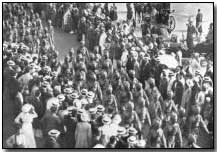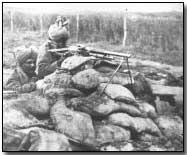Battles - The Battle of Sheikh Sa'ad, 1916
 In the aftermath of the British
defeat at the Battle of
Ctesiphon in November 1915, and the humiliating withdrawal to Kut-al-Amara,
British commander
Sir Charles
Townshend (heading the 6th (Poona) Division) found
his force besieged by
some 10,500 Turkish forces on 7 December.
In the aftermath of the British
defeat at the Battle of
Ctesiphon in November 1915, and the humiliating withdrawal to Kut-al-Amara,
British commander
Sir Charles
Townshend (heading the 6th (Poona) Division) found
his force besieged by
some 10,500 Turkish forces on 7 December.
He consequently sent out urgent appeals for a relieving force. The regional British Commander-in-Chief Sir John Nixon - for whom much of the blame for Townshend's situation could be apportioned - responded promptly.
Having learnt from Townshend that his force had no more than two months of food supplies available to them at Kut, he assembled a relief force under General Aylmer, boosted by the arrival of three new Indian infantry divisions. These were despatched post haste to the British forward base at Ali Gharbi, some 200km upriver from Nixon's Basra HQ.
Aylmer found progress however difficult to achieve, with the British force suffering - as ever - from shortages of available transport, river and road. Nevertheless he set off with 19,000 troops, 46 guns, three monitors and two aircraft on 4 January 1916.
Advancing up the River Tigris Aylmer quickly found his way blocked at Sheikh Sa'ad, a bare 15km upriver from Ali Gharbi (32km downstream from Kut). Turkish commander Nur-Ur-Din had effectively blocked Aylmer's path by placing approximately 22,500 troops and 72 guns on both banks of the Tigris.
 Consequently
Aylmer's initial attack on 6 January - directed against both banks - proved a
rapid failure, with heavy British losses.
Consequently
Aylmer's initial attack on 6 January - directed against both banks - proved a
rapid failure, with heavy British losses.
A repeat of the attack the following, once the bulk of Aylmer's force had arrived, similarly failed, with a British advance along the east bank outflanked by a counter-attack authorised by Nur-Ud-Din.
Repeating the attack yet again on the night of 8/9 January Aylmer was surprised to discover the Turkish trenches unoccupied; the Turkish forces had withdrawn overnight for reasons unknown. Since Nur-Ud-Din could not himself justify his decision to retreat he was summarily dismissed and replaced by Khalil Pasha.
Exhausted and dispirited, the British force had suffered around 4,000 casualties during the engagement for no significant gain. The operation to relieve Townshend at Kut had not been notably advanced.
Click here to view a map charting operations in Mesopotamia through to 1917.
Photographs courtesy of Photos of the Great War website
Observation balloons were referred to as 'sausages'.
- Did you know?
